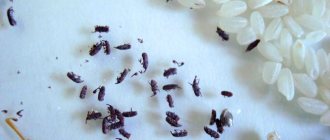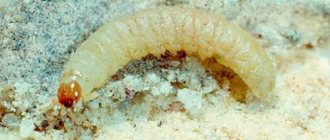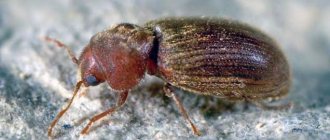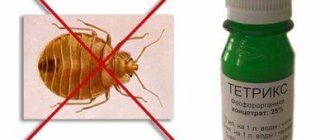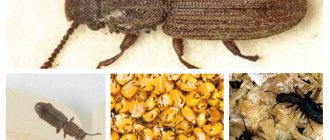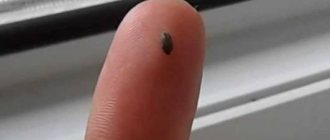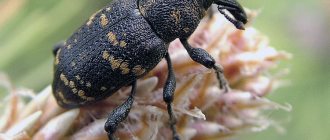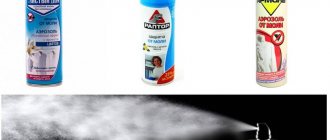Causes of insects
Where do insects come from in kitchen cabinets? Little lovers of cereals and flour live only in these products. They have nothing to eat outside, so it is impossible to bring beetles from there. They won’t fly into the window or crawl away from their neighbors because they don’t travel long distances. The only reason why bugs appear in cereals is poor quality processing by the manufacturer.
If the manufacturer of bulk products neglects the standards for the production and storage of cereals, poorly processes the goods before packaging, insect larvae end up in stores, and from there - in kitchen cabinets. Most often, insects can be found in cereals sold by weight, but sometimes they are also found in hermetically sealed packages.
As soon as even one package of contaminated product appears in the kitchen, an insect invasion soon occurs. From the larvae present in the cereal, bugs hatch, which quickly spread and multiply.
Who will you have to fight with?
Most often in rice and other dry cereals appear:
- bread grinders. These are the most harmful, the most voracious and the most resistant to all control measures taken. But on the other hand, identifying them is easier and faster than all other pests. The presence can be determined by the appearance of the corpses of other larger insects on window sills, or by stains in books. Their length is up to 3.7 mm, but more often the individual does not grow more than 1.8 mm. The color of the shell ranges from sand to brick. They eat absolutely everything. These bugs don't even disdain tobacco;
- Khrushchak. These reddish-brown bugs reach no more than 3.5 mm in length, have round “pot-bellied” barrels and wings (but cannot fly). They enter the house with starch and flour. Buckwheat, semolina, rice, millet and dried fruits are chosen as a “place of residence”. They multiply very quickly. The female gives four generations per year. Infection can be determined by the appearance of lumps;
- flour eaters. From the name of insects it is clear that their favorite product is flour. But they also do not disdain all types of cereals, as well as dry animal food. Their color is rusty, their length is no more than 2.5 mm. There are wings, but the insects do not fly. You can determine their presence in products by moisture content. These bugs produce a lot of excrement.
We recommend reading: SK stored Essentuki from the source Essentuki 4 collected from the well
Is it dangerous to eat food contaminated with bugs?
If there are bugs in the cereal, you should not eat it. It is better to throw away all contaminated products or feed them to birds and animals. If such waste is beyond your means, the products must be thoroughly cleaned. It is better to sort the cereal by hand and sift the flour through a fine sieve.
After there are no visible insects left in the cereal, it must be thermally treated:
- Heat in the oven . Flour and semolina cannot withstand heating above 50°C. Other cereals can be heated to 100-110°C. Processing time – 30-40 minutes.
- To freeze. Place the sorted grains into bags and close them tightly. Place in the freezer for 2-3 days. In winter, you can put the cereal on the balcony or in the courtyard of a private house.
- Keep it in the sun. Spread the product in a thin layer on a baking sheet and place in direct sunlight for several hours.
If you plan to make porridge from the contaminated product right now, you can fill it with salted water. After some time, all the pests will float to the surface.
Important! Even if there are no adults in the croup, white larvae, scales, and insect waste products invisible to the eye will remain in it. To eat or not to eat such a product is rather a matter of disgust. However, it should not be given to young children, elderly people or those with weakened immune systems. Pest residue may cause an allergic reaction.
Types of kitchen parasites
How to get rid of bugs in flour and cereals?
This question worries many housewives, because household pests can appear in any home! We know how to deal with this scourge, and we will be happy to share this knowledge with you! The following pests can appear in the kitchen:
- Bread borer - small (length - 3 mm) light brown insects. They are attracted to book bindings, crushed grain mixtures, coffee, dried herbs, tea, animal feed and dried bakery products (crackers, crackers, cookies, biscuits). The bread grinder flies well - it can fly into a window, guided by the light. But most often, bugs enter the house along with store-bought food and animal feed;
- Weevils are small dark brown or black bugs with a long proboscis. Under favorable conditions, they produce offspring up to 6 times a year. Most often they can be seen in packages with buckwheat, pasta, rice, flour and legumes;
- The flour bug is a small insect (4 mm long) with a red-brown body. These pests are brought into the house along with flour and starch. The flour bug easily penetrates into any container. They happily live in all types of flour, buckwheat, rice, semolina, dried fruits, and rolled oats. These insects reproduce incredibly quickly. Eggs are laid not only in food, but also in the crevices of furniture, as well as in home textiles. Hatched individuals are able to crawl throughout the house in search of food;
- Food moth - the adult resembles a gray butterfly with a body 10 mm long. The reason for its appearance is inadequate processing and storage of food products. Moths can also fly into the kitchen through open windows. Most often it settles in packages of tea, pasta, cocoa and dried fruits. Infected products are covered with a thin cobweb; yellow worms appear in them;
- Red flour beetles are miniature bugs (length - 2.5 mm), the source of infection of which is low-quality grain food for pets. It is a frequent inhabitant of bakeries, mills, and factories. They like to eat grains, cereals and spoiled flour with a moisture content of more than 15%. Unable to find suitable food, the red mucous eater dies.
These photos will help you recognize these bugs.
What to do if there are insects in cereals or flour? We offer several effective ways to combat this unpleasant living creature. Remember, they can only be used when there are a small number of parasites.
In this case, it is recommended to sift the cereal through a very fine sieve, pour it onto a baking sheet and fry at a temperature of 110 degrees for 20 minutes. After processing, use these bulk products first.
To get rid of bugs and larvae in the cereal, you need to fry it in the oven - the insects will die immediately
Freezing food for 24 hours will also help kill the bugs.
The easiest way to remove bugs is from beans and peas. They need to be filled with salt water for half an hour. As soon as the insects float to the surface, the liquid is drained and the fruits are thoroughly dried on a dry and clean towel.
With flour the situation is a little different. Experts recommend sifting it through a special sieve with very fine holes, and then heating it in an oven set to 50 degrees.
If there are bugs not only in food, but also in furniture in the kitchen, you need to urgently take measures that will allow you to get rid of not only adult individuals, but also larvae and clutches of eggs.
Step 1. Empty all cabinets of boxes and bags of cereals.
Step 2. Immediately flush any spilled food down the toilet - it may contain parasite eggs.
Step 3. Wipe the surfaces with water and vinegar (1 tbsp per 1 liter of water).
Step 4. All holes and cracks must be filled with boiling water.
Step 5. Wash jars for storing flour and cereals with soap and rinse with very hot water.
Step 6. Wash textile bags in saline solution and dry without rinsing. After this treatment, the bugs will no longer be able to lay eggs.
Step 7. Pyrethrum (Persian chamomile powder), a natural insecticide that allows you to fight household pests without harming your own health, will also help remove insects. It is scattered inside cabinets or poured into fabric bags. Repeat treatment once every 1.5 weeks.
Step 8. You can use bait to lure kitchen bugs out of secluded crevices. There are several recipes for their preparation.
Recipe 1. Mix powdered sugar, borax and fine grains. Place a small amount of the mixture on sheets of paper and place them around the kitchen.
Recipe 2. Combine powdered sugar with borax and millet, crushed in a coffee grinder (take everything in equal quantities). Roll small balls, dry them slightly and place them in cabinets.
Recipe 3. Mix sugar, borax and dry yeast. Pour the composition onto pieces of paper and place on the shelf.
Step 9. The best remedies for food moths are lavender and wormwood. You can use both the plant itself and essential oil. In the first case, small bouquets are made from fresh or dried twigs, in the second, a piece of cotton wool is soaked in essential oil. Anti-bug esters also include basil, geranium, cloves, fir and rosemary.
Step 10. Most beetles are afraid of sunlight. When you come home from the store, pour the cereal into glass jars without lids and place them on the windowsill.
Any woman spends a lot of time in the kitchen. It gives great pleasure to watch your husband and children eagerly devouring another culinary masterpiece or the most ordinary dish. But there are situations when the most careful housewife discovers an unpleasant problem in her kitchen - insects in cereals and flour.
Before you completely remove the bugs that have infested in cereals and cupboards, you need to throw away all the cereals in which they were found. Some people cook this cereal and feed it to backyard birds, which are not afraid of bugs; this is their daily food.
You cannot limit yourself to simply getting rid of contaminated products. After all, larvae can be on packages with other products that were lying nearby, on doors, and in the corners of cabinets.
The next thing you should definitely do when fighting bugs is to wash the cabinet with detergent and then treat it with vinegar. Banks in which spoiled cereals were stored must also be processed.
Have you decided to cook delicious and healthy porridge for dinner, but noticed small insects among the grains of rice? Do not rush to get upset and worry about your health - such insects are not dangerous to humans, but, of course, they discourage any desire to cook dinner.
Naturally, you can throw out all the cereals and other bulk products, but why spend money on buying new products if you can get rid of unpleasant guests on your own? And we'll tell you how to do it.
To know how to get rid of bugs in cereals and flour in the kitchen, you must first understand what kind of insects you are dealing with. Only in this case can you find the most effective remedy.
The flour beetle is a small brown pest that belongs to the order Coleoptera. Its main habitats are mills and granaries, from where, in fact, it then ends up in bags of cereals or flour.
The lifespan of a mucoed under favorable conditions is approximately three years. During this time, the insect can lay up to 300 eggs. If favorable conditions are created (humidity about 65% and air temperature about 2-5 degrees), the bugs will begin to multiply several times faster.
food moth
The food moth is a small butterfly with a length of up to 1 cm. Such insects live for only a few weeks, but during this short period one individual is capable of laying about 400 eggs, which very quickly turn into caterpillars. They are the ones who spoil all the products they meet on their way. After this, the larvae turn into pupae, which turn into butterflies, which are again ready to produce offspring.
Have you noticed that after sleeping in your favorite bed you start to itch? Perhaps these are dust mites that settle in linens, clothes, mattresses and do not allow you to live in peace. But we will help you quickly solve this problem without resorting to the help of specialists.
Bed bugs are no less dangerous organisms that, for various reasons, can settle in our homes. But fear not, there are some valuable tips here for removing insects from linens, clothes and furniture.
We suggest you read: How to distinguish fleas from lice, what they look like and the difference between their bites
Undoubtedly, using toxic drugs to treat the kitchen is not the best option. And all because a lot of products are stored here, which means it is not safe. Secondly, why use powerful drugs if there are more practical and safe means?
Beetles living in cereals and flour cannot tolerate frost and heat. You can get rid of them using heat treatment. So, if you find uninvited guests in winter, simply take all the cereals and other bulk products out onto the balcony. The only condition is that the temperature must be at least 15 degrees. A few hours and the insects will die. This method is very suitable for flour and semolina, because after “freezing” the products will not change their taste and color.
But it is better to process cereals with “heat”. Simply pour the contaminated pasta or rice onto a baking sheet and place it in the oven for half an hour. The insects will die within 15 minutes if the temperature in the stove is at least 50 degrees. After heat treatment, sift the cereals through a sieve.
If you need to destroy mucoeds, then exposure to ultraviolet light will do. Just take the cereal outside - after 5-10 minutes the insects will feel uncomfortable and try to find a more comfortable place for themselves. True, this option is only suitable for warm summers.
food moth
- After you have inspected the grains and flour, cleaned it and got rid of bugs, wash all cabinets and drawers with any disinfectant, both outside and inside. Instead of household chemicals, you can use a vinegar solution, which copes well with various types of contaminants. When finished, leave the surfaces to dry for about a day.
- The shelves need to be covered with paper, and on top you can put garlic, laurel leaves or dry lavender.
Pest prevention
There are many ways to get rid of bugs in cereals in the kitchen. However, this cannot be done forever. There will always be a possibility of buying a low-quality bulk product again.
To minimize the risk, preventive measures should be followed:
- Purchase products only from trusted manufacturers . Preference is given to sealed plastic packaging. Do not buy bulk cereals that appear to be of obviously poor quality.
- Buy groceries only for a short period . It's good to have supplies of essential goods. But in completely filled kitchen cabinets, there is a higher risk that bugs will fill all the packs, which then have to be thrown away.
- Use storage containers . Glass jars that close tightly for bulk products are the best option. They will not protect against the appearance of pests, but will not allow them to spread beyond the container. As a last resort, open bags should be closed with a paper clip or clothespin and tied with an elastic band.
- Conduct regular audits. Once a month, it is advisable to sort through existing food supplies and throw away what has become unusable. Something that has been lying around for a long time, but is still suitable, should be consumed first.
- Do the cleaning. Crevices and corners of cabinets clogged with crumbs and food residues are cozy places for pests. Keeping your kitchen clean is an important preventative measure.
To repel insects, you can put fabric bags and sachets with aromatic herbs and spices in the closet. Lavender, wormwood, nutmeg, and cloves are suitable.
Ways to get rid of bugs
To get rid of bugs, it is necessary to carry out a whole range of measures to destroy not only them themselves, but also their offspring, waste products. And first of all, this is, of course, to carry out high-quality cleaning. Armed with rags and sponges, you will have to open all the kitchen cabinets and empty and treat all the shelves and drawers.
It is necessary to carefully sweep away any remaining grains that may have spilled and simply wipe everything with a dry or slightly damp cloth. After this you can proceed to processing:
- Table vinegar copes well not only with adult individuals, but also with their larvae and eggs.
- Therefore, you need to dilute 9% vinegar approximately 1:1 with plain water and wipe all surfaces with this solution. And not only the horizontal shelves themselves, but also the vertical ones, including the doors.
- Particular attention should be paid to the joints. If your furniture allows it (not varnished), you can pour the solution into a spray bottle and spray hard-to-reach joints, for example, in the area of hinges on doors.
- Then dry the furniture thoroughly so that it does not get wet or deteriorate.
- Soda-salt solution can be used instead of vinegar. Dissolve a couple of tablespoons of ordinary rock salt and a spoonful of baking soda in a liter of warm water, stir well, the solution is ready.
We suggest you read: How to get rid of a furniture grinder
Now let's move on to storage containers:
- If you choose glass or plastic containers for storage, then you need to not only wash them, but also thoroughly rinse them with boiling water, which will kill the bug eggs.
- If you store cereals in fabric bags, then they should not only be washed, but also boiled.
- It’s better not to do anything with plastic bags, but simply throw them out and straight into the garbage disposal, and not into the trash can in the kitchen, from where the parasites will quickly crawl back out.
After the main shelters of the bugs have been eliminated and processed, it is worth moving on to the remaining items. It is advisable to wipe everything with vinegar solutions: refrigerator, microwave and other appliances and furniture:
- Pyrethrum helps well; it is a flower powder that is made from Caucasian chamomile, absolutely organic and safe for humans and pets. It should be sprayed carefully in cabinets. To do this, you can simply pour a little onto a dry palm and blow gently in the direction of the shelf you need. Make sure that the powder gets into the cracks and joints.
- If your pest is a food moth, then in addition to the procedures described above, it is necessary to add treatment with any chemical agent for ordinary moths. Moreover, you also need to spray carpets, rugs, and upholstered furniture, if any.
If you choose glass or plastic containers for storage, then you need to not only wash them, but also thoroughly rinse them with boiling water, which will kill the bug eggs
Types of kitchen bugs
There are several types of small bugs in the kitchen:
| Name | Peculiarities | Where does it start? |
| Bread grinder (pharmacy beetle, leather beetle) | Common type. Little brown bugs. Can fly | Flour products, pharmaceutical plants, books, tea, coffee, grain mixtures |
| Flour beetle | A small black bug with horns. Prolific. Even a sieve will not help with eggs in flour - they are too small | Flour, semolina, starch, dried fruits, bran, cereals: buckwheat, rice, oatmeal |
| Red mukoed | A red oblong bug with long horns. Enters the house with low-quality animal feed | Cereals, grain products, flour (especially old) |
| Suriname mucoed | Similar to the red mule eater, but lighter in color | Flour, grain, cereals |
| food moth | A flying insect similar to a common moth. The only kitchen pest that enters the house not only with low-quality products, but can also fly through ventilation or a window | Dried fruits, pasta, tea, cereals: buckwheat, rice, semolina, rolled oats |
| Rice weevil | An oblong bug in rice, from a distance it resembles an ant. Can fly. Breeds in warmth | Solid cereals: rice, buckwheat, pearl barley |
| Bean grain | An oval-shaped bug with a pattern on the back. Found mainly in legumes | Legumes: beans, peas, lentils, chickpeas, beans, soybeans. Can eat solid cereals |
What unites bugs in the kitchen is that they all multiply quickly and are difficult to remove.
What bugs are found in cereals and flour?
Many people believe that kitchen pests arise only as a result of gross violations of sanitation and hygiene standards. Unfortunately, it is not. Flour bugs can live in your food, even if you regularly do thorough wet cleaning. The main reason for the appearance of parasites is non-compliance with control standards at food production enterprises. Some manufacturers ignore even such a mandatory procedure as heat treatment, not to mention high storage standards.
You can detect black bugs in cereals even if you purchased the product in vacuum packaging. Insects usually have plenty of time to “invade” while the product is awaiting packaging. Bugs in the kitchen do not limit their stay to one “house”. They quickly and willingly master new nutrient environments, while not forgetting about future generations.
Parasites reproduce very quickly and fruitfully. The answer to the question of how to get rid of insects in cereals and in the cupboard will be incomplete if it does not contain information on how to find and destroy egg-laying insects. And they can be located almost anywhere, including the most inconspicuous crevices in furniture. Fortunately, this problem can usually be dealt with without the help of strong chemicals.
Many thrifty owners are interested in what to do if there are bugs in the rice. Is it possible to eat it or is it better to immediately throw it away out of harm’s way? Ideally, spoiled products should be disposed of. Elementary disgust has not yet been abolished, in addition, even a mass thoroughly cleaned of adult individuals may contain the remnants of their vital activity.
We suggest you read: How long can you listen to music in an apartment day and night: What to do if your neighbors play music loudly
If you are thinking about how to get rid of bugs in the kitchen and at the same time do not want to throw away spoiled food entirely, the processing should be as thorough as possible. In the case of flour, you will need a sieve with the smallest mesh possible. Not only adults should remain on the grill, but also the larvae and debris they produce.
However, it is not enough to simply remove insects in flour in the kitchen. To gain complete confidence in the safety of purified food, it must be subjected to thorough heat treatment. There are two ways to influence insects with temperature. You can finally get rid of the flour bug by placing the sifted mixture in the oven.
What to do if insects are found in cereals? How to get rid of them without throwing away the entire product. In such situations, the cleaning process is even easier. Simply pour salt water over the rice, beans or beans and leave for a few minutes. After some time, all the bugs in the cereal will separate from the main mass and float up, as well as their derivatives.
Restorative actions make sense only when only a small part of the main mass is affected. If insects in cereals or flour have left behind an impressive “web” of yellow worms, you should come to terms with the loss and do everything to ensure that a similar situation does not happen again. Spoiled food should be thrown away along with its container. The bag or sack is carefully packed in sealed cellophane and only then taken out of the house.
If bugs appear in cereals, how to get rid of them is an important issue for preserving other products.
| Name | Habitat Features | Where are they found? |
| Bread grinder | Able to fly, not afraid of light, found between window frames. Penetrates with animal feed | • Bakery products. • Medicinal herbs. • Tea. • Coffee. • Cocoa. • Cereal mixtures. • Book bindings |
| Flour beetle, beetle | The pest is highly prolific. The eggs are microscopic in size and easily pass through the sieve opening. | • Flour.• Starch.• Rolled oats.• Semolina.• Bran.• Dried fruits.• Rice.• Buckwheat |
| Red mukoed | Comes with low quality animal feed | • Cereals.• Grains.• Expired flour |
| food moth | The reason why the insect appears is improper food storage, ventilation, or an open window. Active mainly at night | • Buckwheat.• Hercules.• Semolina.• Pasta.• Rice.• Flour.• Tea.• Dried fruits |
| Rice weevil | It is highly fertile, reproduces quickly, and flies well. It has a powerful mouthparts, thanks to which it is able to gnaw through grain. The optimal temperature for reproduction is between 26-30 degrees | • Rice.• Buckwheat.• Wheat.• Barley |
| Bean grain | Completely eats up beans and cereals | • Beans.• Beans.• Peas.• Lentils.• Soybeans.• Chickpeas |
Food should not be consumed together with insects. Before using cereals, you need to get rid of pests.
However, even careful processing will not be able to remove larvae, scales, and waste products of beetles. They pose no danger to a healthy adult.
Before using cereals you need to get rid of pests
It’s a different matter when it comes to children and people with weakened immune systems. In these cases, the use of such products can cause a severe allergic reaction or cause intoxication of the human body, which will lead to disruption of the functioning of the gastrointestinal tract and an increase in body temperature.
How to get rid
Getting rid of kitchen pests is not an easy process and requires an integrated approach. The first thing to do is to find the source of the infection and get rid of it. Conduct an audit of all products. Throw away or sort out spoiled ones. Clean, wash, clean out the entire kitchen and cabinets. Then use one of the industrial or home remedies for treatment.
Folk remedies
To remove pests, the following folk remedies will help:
- Vinegar. Wash the inside of cabinets and all kitchen surfaces, including the floor, with hot water and vinegar. Treat corners and crevices especially carefully.
- Laundry soap . Dark, with a high percentage of fatty acids content is suitable. Grate and dissolve in a bucket of hot water. Use for cleaning furniture and floors.
- Borax. Mix with powdered sugar or flour. You can add raw egg, honey. Spread the mixture on flat lids or sheets of paper and place it in the beetles’ habitats. They will eat the bait and bring it with them to the colony, poisoning themselves and poisoning others.
- Vegetable oil . Place small dishes with vegetable oil in places where beetles accumulate. They will taste the oil and drown in it. The oil needs to be changed periodically.
It is believed that bugs in cereals do not like the strong smells of bay leaves, lavender, garlic, wormwood, and nutmeg. It is recommended to arrange containers and lay out bags with these products. However, there is no guarantee that odors will repel absolutely all types of bugs.
This is interesting:
How, where and for how long you can store pasta.
Is it possible to freeze kombucha and how to properly preserve it until next summer.
Secrets of proper storage of yeast dough.
Chemistry to help
Getting rid of pests using folk remedies is a rather long and labor-intensive process. This can be done much faster using special chemicals, but you need to be extremely careful with such drugs, avoid contact with skin and inhalation, and thoroughly ventilate the room.
The following remedies are effective:
- Chlorine-containing preparations (Domestos, Belizna, etc.). Wash all cabinets, shelves, walls and floors in the room with water containing chlorine. Leave all doors open and ventilate the kitchen for several hours. Repeat treatment every other day.
- "Anti-bug." Preparation for insecticidal treatment of wooden surfaces. The effect of the product is not only powerful, but also long-lasting. There is no threat of reappearance of pests for a long time.
- “DALI anti-ant” produced by Rogneda. Despite the name “anti-ant”, the drug is also effective against any insects, including bugs in flour.
- "Dichlorvos". One of the most effective remedies. Spray the kitchen with an aerosol and close it for half an hour. After this, open the windows and doors, turn on the hood and ventilate thoroughly. It is better not to stay in the treated area during the day, even after ventilation.
If folk remedies and store-bought preparations do not help remove uninvited guests from the kitchen once and for all, there is one last method. It is necessary to call a team of specialists involved in treating premises from pests. But in this case, you need to leave the apartment for a while. It is better not to enter the house for at least a day after treatment.
Important! Health and safety must be taken into account when treating your kitchen with chemicals. Remove all food products and indoor plants from the premises, and remove children and pets from the apartment during treatment. Wear gloves, long sleeves, a respirator or a medical mask. After treatment, thoroughly ventilate the room.
Chemicals
Ready-made chemical pest control products provide the fastest results.
Dichlorvos
"Dichlorvos" is a universal insecticide that helps get rid of a number of different insects. The only drawback is that the spray has an extremely unpleasant odor and belongs to the category of toxic substances.
Before use, remove food from cabinets and gather kitchen utensils that are in plain sight. Pack everything in a box and take it to another room.
Wash the cabinets, let them dry, put on safety glasses and gloves, spray the spray and leave the apartment for at least half a day.
White
“Whiteness” is not the most reliable “friend”; it poses virtually no threat to bugs and will not allow you to get rid of them, so you should not torture furniture with a chlorine-containing product. But it’s great for prevention.
To prepare the composition, combine ¼ bottle of Belizna, 10 tablets of Levomycitin and 5 liters of water. Mix well and use for general cleaning in the kitchen.
Other drugs
- "Food bug trap." It is recommended to lay the structure on a horizontal surface so that it receives sunlight, since it is an activator of the chemical composition. One trap is capable of collecting bugs from an area of 20 m² and is valid for 12 months. With it you can get rid of the bread borer, black leather beetle, rice weevil and beetleworm;
- "Raid Lavender". A universal remedy for various flying and crawling insects. The aerosol must be sprayed onto the surface of the cabinets at a distance of 20-30 cm. In addition to bugs in cereals, the product has proven itself in the fight against cockroaches, moths, fleas and spiders.
Is there a way to get bugs out of a bag of rice?
We bought products at a wholesale base, as they say - for good. When my wife arrived home, she found bugs in a bag of rice.
You can, of course, go and demand a replacement package or a refund. But the fact is that it’s a long way to go, so the costs will only increase.
We recommend reading: How long can you store coconut milk?
Does anyone have experience in solving similar issues?
Thanks in advance.
I want to upset you and your wife right away, you will still have to go back to the wholesale center and exchange the product or return the money, but be sure to include a receipt for the purchase and within 14 days. This is a weevil beetle you have, there is no way to remove it, and it also multiplies at the speed of light, where you kept the cereals, be sure to rinse everything with a vinegar solution and throw in chopped pieces of garlic and you should always store it for the future with cereals to ward off these parasites. Good luck to you.
My own experience: we (there were 4 people) were taken on a fishing trip with food, the period was 2 weeks. The same animals were found in the purchased bags of rice, but we didn’t bother, but simply took a fine mesh sieve (approximately 12-13 cm in diameter) and passed all the rice through it.
The rice itself remained, but everything else was sifted, or rather mashed (we had to pour in a little and, as it were, grind the grains on the mesh. In the end, everything turned out not bad, and since the rice was intended for fish soup, we were not particularly worried, almost completely “destroying” it while fishing)
My own experience: we (there were 4 people) were taken on a fishing trip with food, the period was 2 weeks. The same animals were found in the purchased bags of rice, but we didn’t bother, but simply took a fine mesh sieve (approximately 12-13 cm in diameter) and passed all the rice through it.
